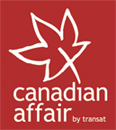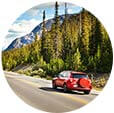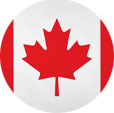Driving in Canada is a spectacular experience and is the most popular way to see this magnificent country. The sky-rending peaks of the Rocky Mountains, the blue depths of Canada’s lakes and the open expanse of the prairie lands are best appreciated by car. There is no better way to explore British Columbia, the Canadian Maritimes and much more than on a fantastic fly drive holiday to Canada.
It was “an amazing experience, and for the most part a very relaxed and enjoyable affair”, says Australian travel bloggers Alesha and Jarryd. The pair from NOMADasaurus spent a holiday driving around the country and exploring. Drive coast to coast and you will travel through six time zones, pass stunning scenery on different brilliant roads, and see incredible sights along the way.
To get the most out of your Canada road trip, read on to discover our top tips to ensure your driving holiday to Canada is a safe, simple and memorable experience.
Download our helpful guide to fly-drive holidays in Canada, perfect to print off and take with you on your upcoming adventures, full of useful lists and top tips. Just click below to save or download.
Click here for the Fly-Drive Guide to Canada
View all of our car hire in Canada options, so you can pick the right option for you and your upcoming adventure.
Preparing for your Canada road trip

The good news is that you can drive in Canada on a full UK driving license, so don’t forget to carry this with you. Remember to take out insurance before you drive so you know you’re covered in any scenario, and keep proof of it with you throughout your travels.
Before visiting Canada, you will need to complete an eTA, allowing you to visit on your Canada holiday, make sure you complete this within plenty of time and carry all the paperwork with you, this way you won’t be caught looking through emails should you need to find it quickly.
Language
Familiarise yourself with some basic French phrases if you are driving in Quebec, which is a bilingual province. Many of the road signs are in French so you may struggle to understand them – we recommend looking up a few key phrases in advance.
French road sign meanings:
Arrêt = Stop
Route barrée = Road closed
Entrée interdite = No entry
Plan ahead
Canada is vast and you may be travelling long distances in the car, so take rest stops often, and always drive with food and water should you not pass any stores before your planned stops. Some roads can be isolated so be sure to take a mobile phone and warm clothing in your vehicle (just in case). Also, keep in mind that some roads will stretch for long distances without a petrol station, so be sure to keep your fuel topped up and checking locations of pit stops ahead of travel.
Rules of the road

What to do and what NOT to do
Probably the first thing that you will notice when you arrive in Canada is that Canadians drive on the right-hand side of the road. This can take Brits a little getting used to, but just take your time and start out slowly – you’ll soon get the hang of it! After this, the most important thing to note is the driving laws in Canada. As Michael Bettencourt, Managing Editor of autoTrader.ca explains, “Driving in Canada is very similar to driving in northern U.S. states. Like there, motoring rules are technically controlled by the province or state, but share many common traits.” Safety for all is paramount, so make sure to follow these rules at all times.
Be safe: it’s compulsory to wear a seatbelt in Canada and you risk a fine for not wearing one, so buckle up.
Canadian speed limits are measured in kilometres per hour. The speed limit on motorways is often 100km/h (62mph) but can be as high as 120km/h in BC and as low as 90km/h in PEI. In built-up areas, it is usually 50km/h (31mph) but will be lower around schools, as in the UK. Watch out for signs and this will be easy to follow.
Daytime running lights are present on every Canadian vehicle, which is one of the many benefits of choosing a car hire in Canada for your holiday. Lights are required to be switched on during the daytime in some provinces – so check this for the area you’re visiting before you travel.
Hannah Logan, MapQuest contributor and writer of Eat Sleep Breathe Travel stresses that; “Another important Canadian road rule to note is that it is illegal to talk on the phone or text while driving. Getting caught using your cell phone while driving will result both in a fine as well as demerit points. Fines differ from province to province.”
Throughout most of Canada, turning right is permitted on red lights, unless a sign indicates not to do so.
Regional and provincial rules

Once you have grasped the basic principles of driving across Canada, it is important to bear in mind some unique aspects to driving that are present in certain Canadian provinces or regions. As Michael explains, a few of these are:
In Ontario, any driver caught speeding at 50 km/h above the posted speed limit can have their car confiscated and towed away, and impounded for up to seven days. So be especially wary near highway construction zones, which often dip down to temporary 80 km/h or less speed limits.
In Alberta, be wary of inconspicuous photo radar units, usually with a police unit parked at the side of the highway, but also with mobile units. Radar detectors are illegal in many provinces, so the best way not to be caught is not to speed!
Writing for Wheels, Laurie Izzy explains advises caution: “Left lane blockers are now subject to a $167 fine and up to three demerit points: A driver of a vehicle in the leftmost lane must exit the lane on the approach of another vehicle in that lane if it is safe to do so.”
Highway etiquette

In Canada, there are several common points of highway driving etiquette which it is advisable to follow to enjoy a smooth experience on the roads. For example, passing is done on the left, with trucks barred from the far left lane. This is particularly important to remember if you’re planning to get around Canada via RV hire. In cities, however, Michael advises staying in the left lane if possible when stopped at a red light, to stop cars turning right whilst having to wait for a green. He also points out that in major cities, it is frowned upon to pass stopped trams (called streetcars in Canada) when they are loading and unloading passengers.
Signs and symbols

The signs and symbols used for driving in Canada are relatively universal, but Michael recommends that visitors be wary, as they’re “much less conspicuous in North America than elsewhere in the world.” Sometimes there is no signage on the roads, so Canadians often use sat navs which have the speed limit shown on the routes, which are a good idea to invest in. Michael also warns drivers to be prepared for many traffic lights, as Canada’s roads are particularly efficient when it comes to safety. Alesha and Jarryd comment that when they visited Canada, the only unique element they came across were four-way stop signs. Here, they explain, “it’s basically the person who arrives at the stop sign first who has right of way. It takes a little while to get used to, but in the end it makes sense.”
Driving in winter

Hannah comments, “I think the biggest concern with driving in Canada is probably the winter weather which can make driving conditions pretty harsh.” She explains, “Black ice is one of the biggest dangers of winter driving in Canada and the cause behind many accidents. While it can’t necessarily be avoided, there are some precautions drivers can take. One of the easiest ways to practice safe winter driving is to make sure your vehicle has winter tyres. These tyres have a much better grip that can handle the cold temperatures unlike all season or summer tyres. It should be noted that winter tyres are mandatory in the province of Québec, and vehicles without them during the winter months can be fined.”
Driving and Canadian wildlife

Canada has a reputation for its wildlife, so while you’re driving around the country you’re likely to come across some amazing animals on the way. However, do be sure to watch out for large animals on the roads – there should be signs to alert you to their presence – do not ignore them! Deer, elk, and moose can be a hazard for cars, especially at night when they are more likely to be mesmerised by your headlights. We recommend you drive slowly, particularly around corners. Michael advises extra caution in Maritime provinces such as Newfoundland, Prince Edward Island and Nova Scotia, where moose are overpopulated. In Alberta, Big Horn Sheep are also common, which could cause some serious damage to your car in a collision – not to mention distressing these beautiful creatures.
Motorhome driving in Canada

Many people choose to travel Canada via motorhome hire, with the combination of convenience and flexibility making this a brilliant way to experience the country. However, there are some particular rules that are important to bear in mind if you plan to drive an RV or camper around Canada. Make sure to keep within each area’s time and length restrictions, and be careful not to take up extra spaces. Research ahead of time where you will be permitted to park because motorhomes are strictly not permitted to camp on any private property, national or Provincial Park, wilderness area or First Nations reservation. Overnight stays are particularly limited.
Look out for rest areas, campsites and some mall car parks – you cannot simply pull over and stay overnight anywhere in Canada. However, some campsites allow you to reserve spaces in advance, which can make life a lot easier, especially in the peak times over weekends and between June and August. As David Williams explains in an article for The Telegraph, staying in a campsite can be a good option:
“In most Canadian campsites RVs plug directly into freshwater, drains and electricity. RVers get their own picnic bench and fire pit; poking a stick into a fire as night falls is almost mandatory, with campsites selling firewood for $5-$7 (£3-£4.50) a bundle.”
Unusual laws
Laurie Izzy also explains that there are a few unexpected driving laws in Canada. One of these is that “you can’t put your vehicle in neutral to save a little fuel mileage while going downhill or give the rpm’s a break while descending down a mountain highway.” The Motor Vehicle Act in British Columbia dictates that when travelling downgrade a driver must not coast with the gears of the vehicle in neutral or the clutch disengaged.
In Québec, sudden braking without cause will add two demerit points to a Canadian’s driving record, so try to drive steadily wherever possible.
“Right turns on a red light in the Province of Québec has been legal since 2003. There is one exception however: On the island of Montréal, red light rights are still a no-no.”
Glossary of Canadian driving terms

5-1-1 – A transportation and traffic information phone line in some regions of Canada that was designed for road weather information.
Concession road – a set of small old colonial roads in southern Ontario and southern Queébec.
Farmer tan – a tan on the lower left arm, caused by driving with the window open wearing a short-sleeve shirt.
Farmer turn – a manoeuvre executed while driving an automobile in urban areas. It usually describes a right turn that starts by veering to the left, often crossing into the adjacent lane before completing the (often slow) right turn.
Line – another term for a concession road.
Out-of-country (OOC) driver – a driver from outside Canada applying for a license.
Out-of-province (OOP) driver – a driver from a neighbouring province.
Parkade – an above-ground multi-storey parking garage.
Ski-Doo – a snowmobile.
Streetcar – a tram.
TransCan, T-Can – common abbreviations for the Trans-Canada Highway.
Wheels – any vehicle, but usually a car.
Where to drive in Canada

There are countless incredible places to visit on a road trip around Canada. Ava Mehta from Ontario Tourism UK recommends a fly-drive holiday around Ontario. She says: “With no major attraction more than three hours from each other, you’ll have more time to venture out and experience what there is on offer. We recommend stopping off at one of the OTIC centres (Ontario Travel Information Centres) which are dotted around on the motorways and are a great place to pick up maps, information and souvenirs.” Alesha and Jarryd, on the other hand, have other recommendations for some truly amazing sights. They suggest visitors drive the Gaspe Peninsula in Québec, the Cabot Trail in Nova Scotia, around Gros Morne National Park in Newfoundland, and the Icefields Parkway from Banff to Jasper. Wherever you choose to visit on your car or motorhome hire holiday in Canada, follow these simple tips and you’ll have nothing to worry about except seeing as many sights as possible!
Popular driving routes:
Sea to Sky Highway, British Columbia
Enjoy continuous views of the coastal mountains, clear blue seas, stunning waterfalls and lush green forestry, not to mention the abundance of wildlife you may encounter on your journey.
Trans-Canada Highway, Lake Louise
Crossing four islands, this is a real adventure through true Canadian countryside. Mighty peaks meet low valleys, cattle farms and glaciers in contrast. If you want to see it all, this is the route for you.
Icefields Parkway, Alberta
Winding through Banff and Jasper National Parks for 143 miles, the Icefields Parkway offers breath-taking views of some of the world’s most spectacular glaciers, waterfalls and lakes, a real spectacle for the eye.
Read our article all about inspirational driving routes in Canada, the perfect guide to give you a little inspiration before planning your perfect driving routes.
If you have any questions or concerns about driving in Canada, a member of our team will be more than willing to help answer any queries. Call us on 020 7616 9999 to book your dream holiday to Canada!







